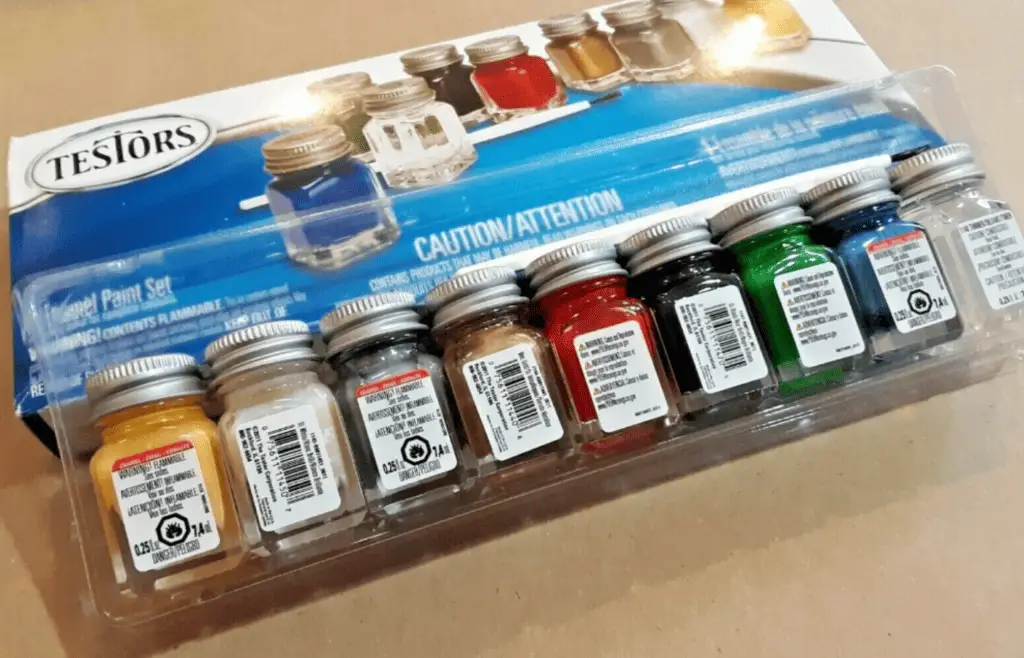Enamel paint is a beautiful type of paint that finishes with a nice gloss and is easy to clean. It’s very easy to find white enamel paint, but what if you want to add a tint to your enamel paint?
Enamel paint can be tinted by adding in a stir-in paint color and mixing both together very well. By adding different amounts of a paint color to a basic white enamel paint, you can end up with a wide range of unique colors from pretty pastels to vibrant shades. However, not all paint color goes with every enamel; you have to choose the right product based on brand.
In order to make sure you tint your enamel paint to your satisfaction, you’ll want to have some basic understanding of color theory and the different ways to mix colors for shade ranges.
Understanding Enamel Paint

Enamel paint is an oil-based paint that is known for its fantastic coverage, durability, and versatility for a variety of surfaces. It tends to be used mostly for painting indoors. There are also enamel paints that are water-based rather than oil-based, and there are some varieties that can be used for outdoor projects.
The composition of enamel paints means they take some time to dry, and they tend to dry in a harder layer than other types of paint. Some good painting technique and a knowledge of paint brushes is highly recommended before you start playing with enamel paints.
To check the current price and availability of Testors Enamel Paint, click here to view the listing on Amazon.
Tinting Enamel Paint
If an enamel paint is suitable for tinting, the brand that creates the enamel paint will usually recommend or manufacture specific stir-in paint colors to use for tinting. These recommendations are essential, as experimenting with mixing paints isn’t recommended without a thorough understanding of paint ingredients and how they interact.
Brands that manufacture enamel paint will usually sell companion products for tinting. Sticking with these companion products is ideal because you know that they were made to mix well with your base enamel paint.
You can find grays, blacks, and whites which act as foundations for color mixing. Of course, you’ll also find your primary colors which are blue, yellow, and red. Shade ranges will vary by brand.
The more pigment is added to your paint, the more saturated that specific color will become. Adding gray or black will make that shade darker, and adding white will make it lighter.
Advantages and Disadvantages of Tinting Enamel Paint

The great thing about tinting enamel paint is you’ll end up with a color that you love and that perfectly fits your vision. You may even end up creating a color that you couldn’t simply purchase in your favorite hardware store. You can also lighten or darken colors you’ve taken off the shelf to complement different areas of your home.
The disadvantages of tinting enamel paint really come down to how complicated it can be to mix paint colors, especially if you have a specific vision or are trying to match a color. Since you’re doing all the mixing yourself, you may not end up with the exact same color every time until you are extremely careful.
You have to be very precise with your measurements of your tints and be patient with yourself. Not all enamel paint is equal in quality, so springing for a good enamel paint can cost money.
How to Tint Enamel Paint
Before you tint your entire batch of enamel paint and end up with the wrong color, pour some of your enamel paint into a separate container after stirring it thoroughly. You should stir your tints as well before using them. Measure out the color so you know exactly how much you’ve used to create your perfect tint. Your best bet is to start with white enamel paint.
If you want a darker color, add gray or black. Adding primary colors such as red, yellow or blue will also help you add orange, green or purple tones to your tint. The more types of tints you add to your base enamel paint, the more complicated the mixture can become if you aren’t familiar with mixing colors.
Take your time when adding tints to your base. Add a small amount of paint color at a time, mix the paints together thoroughly, and see if you like what you’ve created. It’s easier to add more paint later. It’s also easier to lighten up a darker color than it is to do the opposite.
Common Uses for Tinted Enamel Paint
A tinted enamel paint can be used just as diversely as your basic enamel paint, since all you’re doing is adding some color to it. However, tinting enamel paint can help transform your art or DIY project into something unique and customizable. It’s most often used to customize or restore furniture, paint woodworking projects, or freshening up trim and sills around the home.
One great thing you can do with enamel paint is transform dated or faded furniture since enamel paint covers wood and metal very nicely. You won’t lose any of the fine detail of ornate or antique furniture, but you’ll bring new life to a piece with a uniquely tinted enamel paint. You can also refresh trim around your home, especially if it gets scuffed often.
The nice thing about choosing enamel paint over other types of paint is that it offers an incredible gloss finish that doesn’t dull quickly. The paint also makes surfaces much easier to clean without ruining the look of the paint.
Final Thoughts
Enamel paint can definitely be tinted and you can create some beautiful colors. You should make sure you’re researching your enamel paint of choice to see what products that specific brand recommends to tint their paint with or you may end up with unsavory results.
The key to tinted enamel paints you’ll love is learning about color theory and mixing a small batch first. Once you’ve settled on the perfect formula, you can use your tinted enamel paint to transform your home into something that speaks to you and your creative vision.

